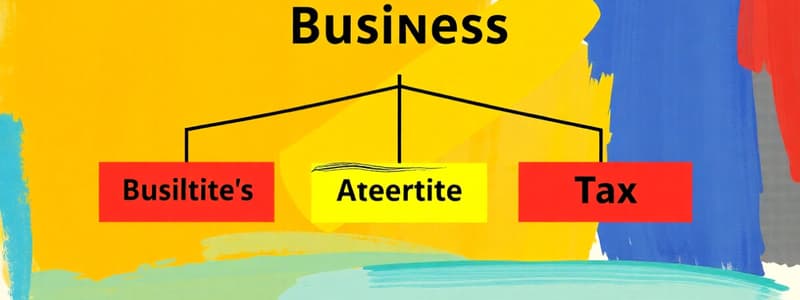Podcast
Questions and Answers
A member's interest in a close corporation can be expressed as a percentage of the total interest in the CC.
A member's interest in a close corporation can be expressed as a percentage of the total interest in the CC.
True (A)
What are the possible contributions for membership in a close corporation?
What are the possible contributions for membership in a close corporation?
- Money (correct)
- Property (correct)
- Services
- All of the above
In a business trust, assets are transferred to ______, who manage them for the benefit of beneficiaries.
In a business trust, assets are transferred to ______, who manage them for the benefit of beneficiaries.
trustees
What is the legal nature of a business trust?
What is the legal nature of a business trust?
Shareholders own company assets.
Shareholders own company assets.
Match the following cases with their major legal principle regarding company assets:
Match the following cases with their major legal principle regarding company assets:
Which business structure would offer John limited liability protection, shielding his personal assets from business debts?
Which business structure would offer John limited liability protection, shielding his personal assets from business debts?
In a general partnership, each partner bears unlimited liability for the business's debts, even if they are not directly responsible for the debt incurrence.
In a general partnership, each partner bears unlimited liability for the business's debts, even if they are not directly responsible for the debt incurrence.
What is the primary advantage of a private company (Pty Ltd) over a partnership in terms of liability protection?
What is the primary advantage of a private company (Pty Ltd) over a partnership in terms of liability protection?
A ______ partner in a limited partnership contributes capital but does not participate in management and has limited liability to their investment.
A ______ partner in a limited partnership contributes capital but does not participate in management and has limited liability to their investment.
Match the types of partnerships with their descriptions:
Match the types of partnerships with their descriptions:
Which of the following business structures provides the most flexibility in terms of management and control for John?
Which of the following business structures provides the most flexibility in terms of management and control for John?
A close corporation (CC) allows for unlimited expansion in terms of membership, making it suitable for rapid growth.
A close corporation (CC) allows for unlimited expansion in terms of membership, making it suitable for rapid growth.
What is the key consideration for John when deciding between a sole proprietorship and a partnership structure?
What is the key consideration for John when deciding between a sole proprietorship and a partnership structure?
Which of the following documents is NOT typically included in a Memorandum of Incorporation (MOI)?
Which of the following documents is NOT typically included in a Memorandum of Incorporation (MOI)?
For a company to distribute dividends, it is sufficient to meet the solvency test.
For a company to distribute dividends, it is sufficient to meet the solvency test.
What is the primary purpose of the solvency and liquidity test?
What is the primary purpose of the solvency and liquidity test?
Directors owe a ______ duty to the company.
Directors owe a ______ duty to the company.
Match the following terms with their appropriate definitions:
Match the following terms with their appropriate definitions:
What is the most crucial factor in determining whether a dividend payment can proceed with the necessary financial tests met?
What is the most crucial factor in determining whether a dividend payment can proceed with the necessary financial tests met?
If a company's total assets exceed its liabilities, it automatically qualifies for a dividend distribution.
If a company's total assets exceed its liabilities, it automatically qualifies for a dividend distribution.
Explain how the solvency test and liquidity test differ in their assessments of financial stability.
Explain how the solvency test and liquidity test differ in their assessments of financial stability.
Which of the following cases is NOT relevant to John's actions concerning conflict of interest and fiduciary duty?
Which of the following cases is NOT relevant to John's actions concerning conflict of interest and fiduciary duty?
The Business Judgment Rule protects directors from liability even if their actions demonstrate a lack of good faith.
The Business Judgment Rule protects directors from liability even if their actions demonstrate a lack of good faith.
What is the Business Judgment Rule used for?
What is the Business Judgment Rule used for?
The fundamental transaction described in the scenario is a(n) ______ or ______.
The fundamental transaction described in the scenario is a(n) ______ or ______.
Match the legal principles to their corresponding descriptions:
Match the legal principles to their corresponding descriptions:
Minority shareholders can only exercise appraisal rights if they vote in favor of the proposed amalgamation.
Minority shareholders can only exercise appraisal rights if they vote in favor of the proposed amalgamation.
What are the key elements that minority shareholders need to fulfill in order to exercise appraisal rights?
What are the key elements that minority shareholders need to fulfill in order to exercise appraisal rights?
Which of the following is NOT a condition for a director to be protected by the Business Judgment Rule?
Which of the following is NOT a condition for a director to be protected by the Business Judgment Rule?
Flashcards
Liability Protection
Liability Protection
The safeguarding of personal assets from business debts.
Management and Control
Management and Control
Levels of authority and decision-making in a business structure.
Tax Implications
Tax Implications
The effect of business structure on taxation liabilities.
Ease of Formation
Ease of Formation
Signup and view all the flashcards
Funding Potential
Funding Potential
Signup and view all the flashcards
General Partnership
General Partnership
Signup and view all the flashcards
Limited Partnership
Limited Partnership
Signup and view all the flashcards
Silent Partnership
Silent Partnership
Signup and view all the flashcards
Memorandum of Incorporation (MOI)
Memorandum of Incorporation (MOI)
Signup and view all the flashcards
Dividend Payment
Dividend Payment
Signup and view all the flashcards
Board Authorization
Board Authorization
Signup and view all the flashcards
Solvency Test
Solvency Test
Signup and view all the flashcards
Liquidity Test
Liquidity Test
Signup and view all the flashcards
Elon Technologies
Elon Technologies
Signup and view all the flashcards
Fiduciary Duty
Fiduciary Duty
Signup and view all the flashcards
Conflict of Interest
Conflict of Interest
Signup and view all the flashcards
Acquisition of Members’ Interest
Acquisition of Members’ Interest
Signup and view all the flashcards
Disposal of Members’ Interest
Disposal of Members’ Interest
Signup and view all the flashcards
Aggregate Interest in CC
Aggregate Interest in CC
Signup and view all the flashcards
Business Trust Structure
Business Trust Structure
Signup and view all the flashcards
Advantages of Business Trust
Advantages of Business Trust
Signup and view all the flashcards
Legal Nature of Trusts
Legal Nature of Trusts
Signup and view all the flashcards
Legal Personality
Legal Personality
Signup and view all the flashcards
Salomon Principle
Salomon Principle
Signup and view all the flashcards
Business Judgment Rule
Business Judgment Rule
Signup and view all the flashcards
Amalgamation
Amalgamation
Signup and view all the flashcards
Appraisal Rights
Appraisal Rights
Signup and view all the flashcards
Self-Serving Actions
Self-Serving Actions
Signup and view all the flashcards
Dissenting Shareholder
Dissenting Shareholder
Signup and view all the flashcards
Companies Act
Companies Act
Signup and view all the flashcards
Study Notes
Q.1.1 Five Factors for Choosing a Business Enterprise Structure
- Liability Protection: Consider whether limited liability is needed to protect personal assets from business debts. A private company (Pty Ltd) offers this protection, but partnerships may expose owners to unlimited liability.
- Management and Control: Different structures offer varying levels of control. Sole proprietorships or members of close corporations (CCs) have direct control. Companies, however, may require shared decision-making with directors.
- Tax Implications: Business structures have different tax liabilities. Sole proprietorships and partnerships are often taxed as personal income, while companies have corporate tax rates. Trusts can offer tax efficiency.
- Ease of Formation and Compliance: Some structures, like sole proprietorships and partnerships, are easier to establish. Others, like companies, require significant regulatory compliance.
- Funding and Growth Potential: The ability to raise capital varies. Companies can issue shares, while partnerships rely on personal contributions. CCs allow up to 10 members, which limits growth.
Q.1.2 Types of Partnerships
- General Partnership: All partners share equal responsibility for managing the business and have joint and several liability for debts.
- Limited Partnership: Includes general partners (managing and unlimited liability) and limited partners (limited liability, no management role).
- Silent/Anonymous Partnership: A silent partner contributes capital but doesn't participate in management; liability is limited to their agreed profit/loss share.
- Universal Partnership: Partners contribute all property (universorum bonorum) or all profits (universorum quae ex quastu veniunt) and share all benefits and liabilities.
- Particular Partnership: Focuses on a specific project or transaction.
Q.1.3 Acquisition and Disposal of Members' Interest in a Close Corporation (CC)
- Acquisition: Members' interest is expressed as a percentage of the total interest. New members join through purchase or allocation, and the amendment to the founding statement must be filed within 28 days. Contributions can include money or property, but not services.
- Disposal: Members can voluntarily transfer or dispose of their interest. Insolvency may lead to the sale of an interest to other members, the CC, or an external party. In case of death, the executor transfers the interest to qualified heirs. The aggregate interest of all members must equal 100%. Transfers are governed by the association agreement and statutory provisions.
Q.1.4 Business Trust
- Structure: The founder transfers assets to trustees who manage the trust for the benefit of beneficiaries.
- Advantages: Flexible setup, limited liability for beneficiaries, and potential tax benefits.
- Control: Trustees have broad powers under the trust deed, including borrowing and lending.
- Legal Nature: Trusts are not separate legal entities; trustees hold legal ownership.
Q.2.1 Legal Personality and Shareholders' Rights
- Shareholder Ownership of Company Assets: Shareholders own shares, not the company assets. The company, as a separate legal entity, owns its assets. Case law supports this principle (Salomon v Salomon & Co Ltd, Dadoo Ltd v Krugersdorp Municipal Council, Airport Cold Storage (Pty) Ltd v Ebrahim).
Q.2.2 Documents Required for Company Registration
- Notice of Incorporation (NOI): Provides the relevant authority (CIPC) with company details (name, type).
- Memorandum of Incorporation (MOI): Outlines the relationship between the company, shareholders, and directors.
- Supporting Documents: Include director identification (ID copies), consent forms, and name reservation proof (where applicable).
Q.3.1 Dividend Payment as a Distribution
- Definition: Dividend is a transfer of a company's assets to shareholders (cash or other benefits).
- Authorization: Board resolution is required to declare and approve dividends.
- Compliance: Solvency and liquidity tests must be met for dividend distribution.
Q.3.2 Solvency and Liquidity Test
- Solvency Test: Assets must exceed liabilities.
- Liquidity Test: Ability to pay debts in the next 12 months.
Q.4.1 Has John Breached His Fiduciary Duty?
- Fiduciary Duty: Directors owe a duty to act in the company's best interest, avoid conflicts of interest, and not exploit opportunities for personal gain.
- Application: John presented a competing product to the local municipality, which is a conflict of interest and a breach of fiduciary duty.
- Relevant Case Law: Regal (Hastings) Ltd v Gulliver, Robinson v Randfontein Estates Gold Mining Co.
Q.4.2 Can John Rely on the Business Judgment Rule?
- Business Judgment Rule: Protects directors who act in good faith, make informed decisions, and act in the company's best interest.
- Application: John's actions were self-serving and not in good faith, so he cannot rely on the business judgment rule.
Q.5.1 Type of Fundamental Transaction
- Identification: The scenario describes an amalgamation or merger (two or more companies combining into one new entity).
- Explanation: Companies' assets and liabilities are transferred into one new company.
Q.5.2 Remedy for Minority Shareholders
- Remedy: Minority shareholders can rely on appraisal rights to receive fair value for their shares if they disagree with a proposed transaction.
Q.6 Business Rescue
- Definition: A process to rehabilitate financially distressed companies to maximize continued operations and provide a better return for creditors than immediate liquidation.
- Key Features: Managed by a practitioner who restructures the company's affairs, business, property, and debts while protecting the company from legal action.
Studying That Suits You
Use AI to generate personalized quizzes and flashcards to suit your learning preferences.




